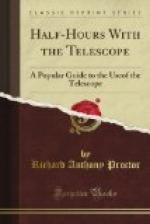It is important that the student should recognise the fact that the highest powers do not necessarily give the best views of celestial objects. High powers in all cases increase the difficulty of observation, since they diminish the field of view and the illumination of the object, increase the motion with which (owing to the earth’s motion) the image moves across the field, and magnify all defects due to instability of the stand, imperfection of the object-glass, or undulation of the atmosphere. A good object-glass of three inches aperture will in very favourable weather bear a power of about 300, when applied to the observation of close double or multiple stars, but for all other observations much lower powers should be used. Nothing but failure and annoyance can follow the attempt to employ the highest powers on unsuitable objects or in unfavourable weather.
The greatest care should be taken in focussing the telescope. When high powers are used this is a matter of some delicacy. It would be well if the eye-pieces intended for a telescope were so constructed that when the telescope is focussed for one, this might be replaced by any other without necessitating any use of the focussing rack-work. This could be readily effected by suitably placing the shoulder which limits the insertion of the eye-piece.
It will be found that, even in the worst weather for observation, there are instants of distinct vision (with moderate powers) during which the careful observer may catch sight of important details; and, similarly, in the best observing weather, there are moments of unusually distinct vision well worth patient waiting for, since in such weather alone the full powers of the telescope can be employed.
The telescopist should not be deterred from observation by the presence of fog or haze, since with a hazy sky definition is often singularly good.
The observer must not expect distinct vision of objects near the horizon. Objects near the eastern horizon during the time of morning twilight are especially confused by atmospheric undulations; in fact, early morning is a very unfavourable time for the observation of all objects.
The same rules which we have been applying to refractors, serve for reflectors. The performance of a reflector will be found to differ in some respects, however, from that of a refractor. Mr. Dawes is, we believe, now engaged in testing reflectors, and his unequalled experience of refractors will enable him to pronounce decisively on the relative merits of the two classes of telescopes.
We have little to say respecting the construction of telescopes. Whether it is advisable or not for an amateur observer to attempt the construction of his own telescope is a question depending entirely on his mechanical ability and ingenuity. My own experience of telescope construction is confined to the conversion of a 3-feet into a 5-1/2-feet telescope. This operation involved some difficulties, since the




